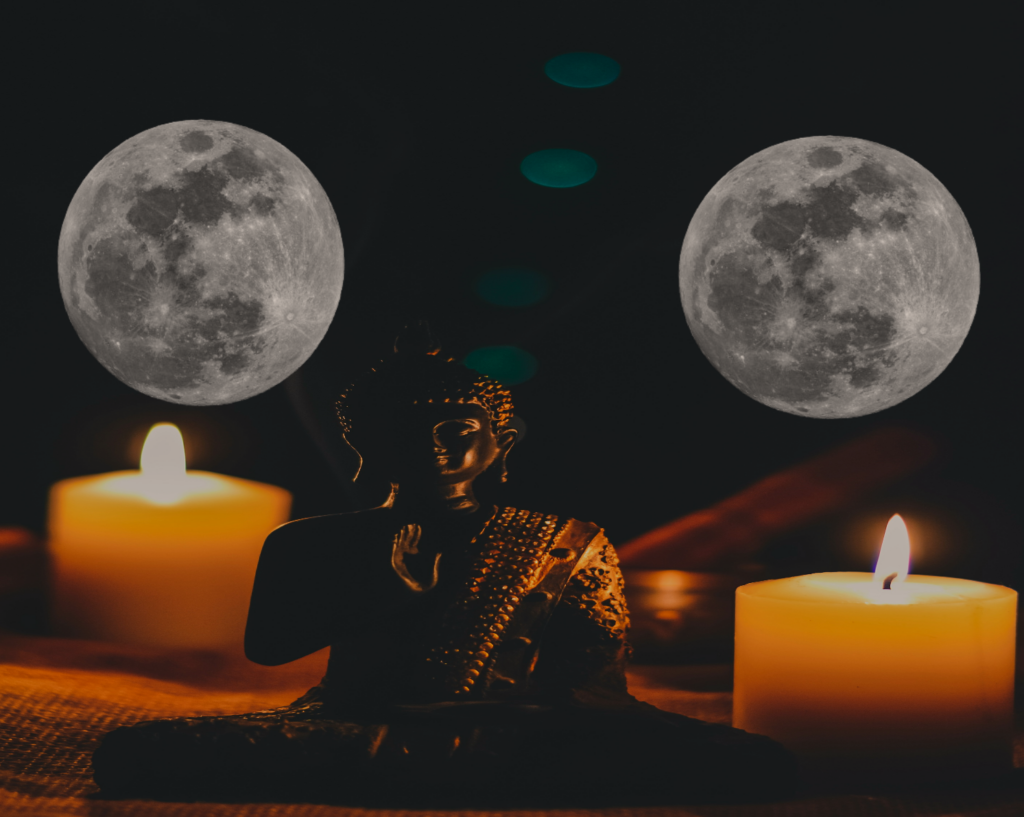
Vaishakha Purnima, the full moon in Vaishakha month, matters much. For Hindus and Buddhists, it’s special. It marks two meaningful events. Buddha Purnima celebrates Buddha’s birth anniversary. And Vishnu devotees observe Satyanarayan Vrat. In 2024, it falls on May 23, Thursday. It invites all to explore traditions.
The Vaishakha Purnima’s Significance
Vaishakha Purnima is spiritually and culturally vital. It has two interconnected celebrations:
- Buddha Purnima honors Gautam Buddha’s birth, enlightenment, and passing away. It reminds Buddhists of his compassionate teachings. It’s about non-violence and seeking enlightenment. It highlights inner transformation and ending suffering.
- Satyanarayan Vrat is for Lord Vishnu devotees. They fast for Vishnu’s avatar, Lord Satyanarayan. They narrate Satyanarayan Katha. It praises truthfulness and devotion. They seek well-being and prosperity.
Also Read – Celebration of Buddha Purnima: Buddha jayanti 2024
Buddha Purnima allows Buddhists to revere Gautam Buddha’s life and teachings. Satyanarayan Vrat gives Hindus a chance to honor Lord Vishnu. Together, Vaishakha Purnima celebrates spiritual growth and self-improvement. It’s a day of profound significance across traditions.
Celebrating Vaishakha Purnima, Honoring Sacred Traditions
The festive occasion of Vaishakha Purnima embraces rituals that unite Hindu and Buddhist faiths.
For Vishnu Devotees
- At dawn, they bathe to purify body and mind.
- They adorn white attire, signifying purity.
- Altars bear Vishnu’s image, adorned with sweets, flowers, fruits.
- The Satyanarayan Vrat involves reciting sacred texts, hymns, prayers.
- It concludes with a communal meal, fostering gratitude, unity.
For Buddhist Followers
- Processions carry Buddha statues, honoring his enlightened life.
- Group meditations cultivate mindfulness, essential teachings.
- Kheer, a sweet rice pudding, signifies spiritual nourishment.
- Discussions delve into Buddha’s profound Four Noble Truths.
- The day fosters compassion, wisdom, inner peace.
Buddha Purnima Practices
This day offers a chance to deepen spiritual practices. Devotees embrace Buddha’s timeless teachings on mindfulness, compassion. Rituals foster inner growth, community bonding, enlightened living.
- Chanting: Chanting Buddhist texts and mantras purifies the mind, creates positivity and spiritual growth.
- Offerings: People give flowers, incense sticks, candles, fruits and sweets at Buddhist temples. These offerings show respect, thankfulness and life’s impermanence.
- Kindness: Buddha Purnima encourages generosity and compassion. People donate, volunteer or help others in need.
- Meditation: Meditation is vital in Buddhism. Buddha Purnima is ideal for inner peace and mindfulness. Techniques like mindfulness, loving-kindness and Vipassana quiet the mind.
Dos and Don’ts for Vaishakha Purnima
For meaningful and respectful Vaishakha Purnima observance, follow these:
Dos
- Stay clean: Start with a holy bath, wear clean white clothes for purity and peace.
- Participate: Engage in appropriate rituals, prayers based on faith, like Satyanarayan Vrat or Buddhist practices.
- Be mindful: Watch your thoughts, words, actions. Cultivate kindness and compassion for all beings.
- Ponder Buddha’s and Lord Vishnu’s teachings. Seek wisdom for your spiritual path.
- Spread positive messages and teachings. Foster harmony and understanding.
Don’ts
- Avoid ill thoughts and harmful speech. Cultivate positivity.
- Embrace non-violence. Refrain from harming any being.
- Abstain from alcohol and mind-clouding substances.
- Practice moderation in activities. Focus on spiritual nourishment.
Following these guidelines ensures meaningful Vaishakha Purnima observance respecting traditions.
Vaishakha Purnima celebrates profound Lord Vishnu and Buddha teachings. It’s for introspection, gratitude, spiritual renewal. Embody compassion, wisdom, inner peace by mindful practices and kindness. Honor this day’s spirit, contribute to harmony and enlightenment.